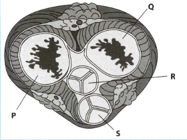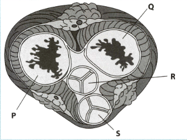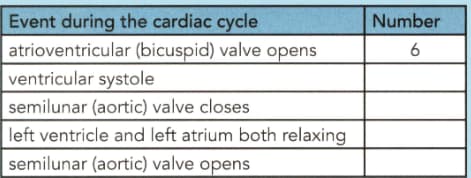The given diagram shows a cross-section of the heart at the level of valves.

Complete the following chart to show the pathway of the blood through heart.




Important Questions on Transport in Mammals
Use the given dissociation curve in the given figure and answer the question:

If 1 gm of fully saturated haemoglobin is combined with 1.3 cm3 of oxygen, how much oxygen will 1 gm of haemoglobin in the capillaries in the lungs be combined with?
Use the given dissociation curve in the given figure and answer the question:

How much oxygen will 1 gm of haemoglobin in the capillaries of this muscle be combined with?
The following statement was made by the candidate in an examination answer. Explain what is wrong with this statement.
Each red blood cell can combine with eight oxygen atoms.
The following statement was made by candidate in an examination answer. Explain what is wrong with this statement.
Red blood cells have large surface area so that many oxygen molecules can be attached.
An enzyme in red blood cells catalyses the reaction between carbon dioxide and water as the blood flows through the respiring tissues.

Name the enzyme that catalyses this reaction.
The given diagram shows a cross-section of the heart at the level of valves.

Explain how the valves P and Q ensure the one way flow of blood through the heart.
The cardiac cycle describes the events that occur during one heartbeat. The following figure shows the changes in blood pressure that occur within the left atrium, left ventricle, and aorta during one heartbeat.

Copy and complete the table below. Match up the event during the cardiac cycle with an appropriate number from 1 to 7 on the diagram. You should put only one number in each box. You may use each number once, more than once or not at all. The first answer has been completed for you.
.
